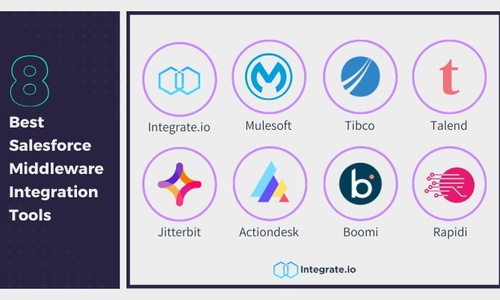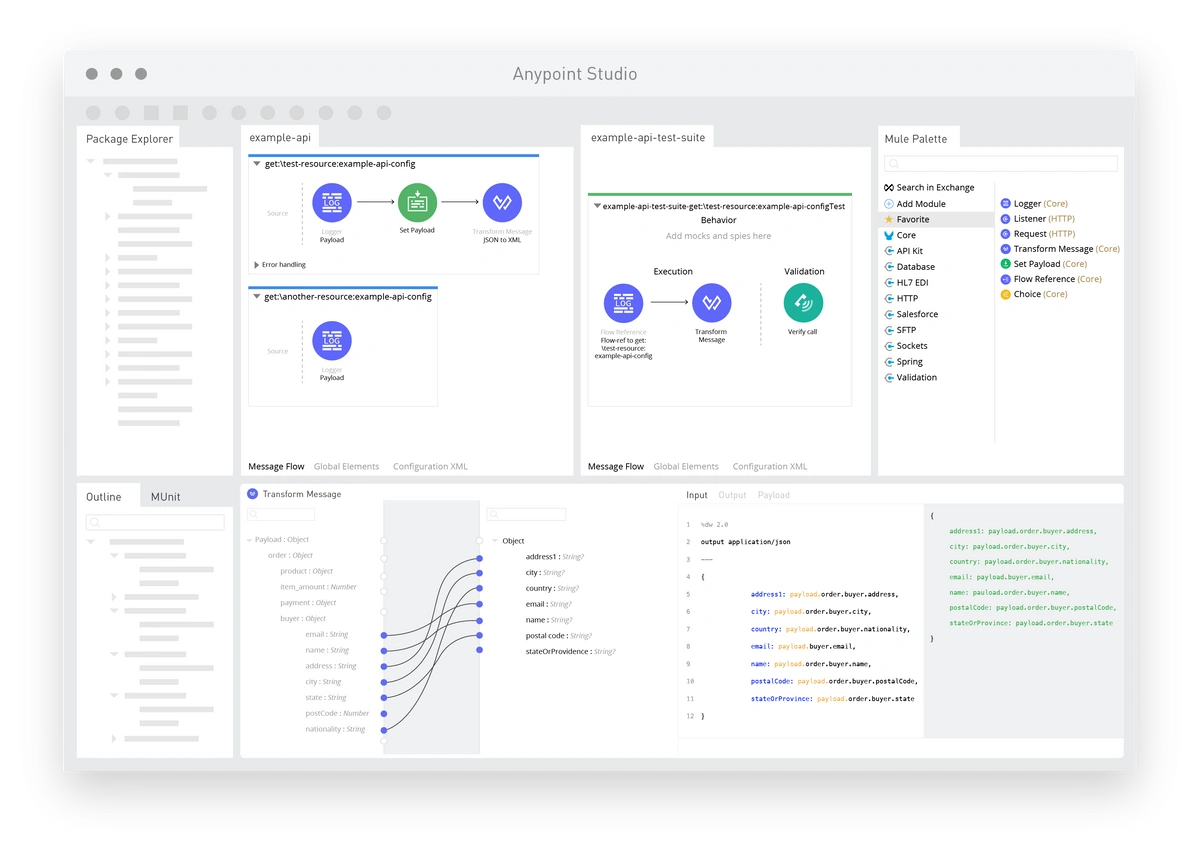- What is Salesforce Middleware?
- Why Use Salesforce Middleware Integration Tools?
- What to Consider When Looking for Salesforce Middleware Integration Tools
- Integrate Salesforce Data Simply With Integrate.io
- Salesforce Middleware FAQs
Salesforce is among the leading CRM software platforms for collecting and leveraging user data to make smart sales, marketing, and customer support decisions. However, other software in your tech stack can benefit from such data. With the right Salesforce middleware, you can exchange data easily with your other critical tools.
Here are the key takeaways you should know about Salesforce middleware:
- Salesforce middleware allows you to connect Salesforce to other applications or data sources to exchange data.
- Salesforce middleware improves data access and allows you to receive data updates in real-time. Middleware transforms data to appear in readable and usable formats in connected systems.
- Middleware-connected systems can leverage exchanged data to complete tasks, update databases, and fulfill other functions.
- When shopping for Salesforce middleware, you should consider each platform's feature set, price, and customer support options.
- Some of the top Salesforce middle platforms include Integrate.io, MuleSoft, TIBCO, Talend, Jitterbit, ActionDesk, Dell Boomi, and RapidiOnline.
Keep reading to dive deeper into Salesforce middleware and discover the best tools for connecting your existing tech stack with Salesforce.
What Is Salesforce Middleware?
Salesforce middleware is a tool that allows you to connect Salesforce to other applications or data sources. The tool seamlessly integrates Salesforce with other software to facilitate seamless data exchange between the connected systems.
Salesforce and the other connected systems can leverage exchanged data to complete tasks, update databases, and fulfill other functions. In summary, Salesforce middleware serves as a bi-directional data bridge to link Salesforce to other systems. Besides transmitting data, middleware transforms data to appear in readable and usable formats in connected systems.
Why Use Salesforce Middleware Integration Tools?
Modern businesses rely on user data to identify opportunities and make smart decisions that fast-track achieving company goals. Salesforce offers loads of valuable customer data you can use to your advantage. However, with Salesforce middleware integration, you can better utilize your Salesforce customer data by leveraging it in your other applications and systems.
For example, middleware helps you connect Salesforce to your marketing automation and customer support tools. Marketing automation tools can use customer data from Salesforce to personalize marketing messages so they are more effective.
Your customer support tool will equally benefit because it can access customer interaction records from Salesforce and use it to resolve new or existing customer issues.
Other benefits of leveraging Salesforce middleware to create an interconnected tech ecosystem are:
- Better data: Salesforce has valuable customer data, but not all of it. Salesforce integration with other applications will fill its customer data gaps to enrich your existing customer data.
- Improved data access: Storing all your customer data in a CRM like Salesforce isn’t optimal. Since Salesforce middleware tools facilitate data synchronization between connected systems, you can view relevant customer data in other systems.
- Real-time data updates: Thanks to seamless data synchronization, any data changes in one system will immediately reflect in the connected systems. The automatic real-time data update eliminates the hassles and risks of manually updating data across multiple systems. It also ensures that team members across various departments always have access to the latest data.
What to Consider When Looking for Salesforce Middleware Integration Tools
When shopping for Salesforce middleware tools, there are three things to consider: features, price, and customer support options.
Features
The best Salesforce middleware tools are user-friendly and offer features that simplify connecting systems and transferring data.
For example, the middleware should have connectors for easily integrating systems you already use. It should also support ETL (extract, transform, and load) to ensure data transfers to other systems in a usable format.
Price
Salesforce middleware integration tools come at different prices. Choose a product that fits your budget and offers the features you need. For example, a cheaper middleware tool that can’t support all your team members isn’t worthwhile.
Customer Support
If you run into trouble while using middleware, you should be able to get help quickly. Choose a middleware provider with dependable 24/7 customer support. Also, you should be able to reach customer support via your preferred channel, such as live chat, phone, or email.
Let’s now look at the top eight Salesforce middleware integration tools for connecting your tech infrastructure.
1. Integrate.io
Rating: 4.3/5.0 (G2)
Key Features:
- Built-in Salesforce connector
- ETL and reverse ETL
- ELT and CDC
- Data observability capabilities
Integrate.io is a user-friendly, third-party ETL tool for Salesforce middleware integration. It facilitates seamless integration between Salesforce and other applications so you can extract data from or load data into Salesforce to gain valuable, real-time customer insights. You can also use the data to automate various processes.
Connecting Salesforce to other systems to achieve a two-way data stream is hassle-free with Integrate.io because it comes with several connectors. The middleware also provides easy ELT and CDC between connected systems. Lastly, Integrate.io’s low-code, drag-and-drop interface lets you configure Salesforce integrations within minutes.
Integrate.io pricing is tailored exactly to each client's needs and requirements with a usage-based component couple with features and functionality. Clients choose which level of platform usage they will require and then which features and functionality to create a custom plan to fit their use case.
2. MuleSoft
Rating: 4.5/5 (G2)
Key Features:
- ETL and ELT data integration
- Two-way Salesforce integration
- Pre-built connectors for other applications
MuleSoft is another reputable Salesforce middleware integration tool. Its Anypoint Platform allows you to connect to Salesforce and other software to retrieve or send data.
It supports ETL and ELT data transfers, but compared to Integrate.io, MuleSoft has a steeper learning curve and price. For full pricing details, you'll need to contact sales.
3. TIBCO
Rating: 4.3/5 (G2)
Key Features:
- Pre-built connectors
- API-led or event-driven integration options
- Custom connectors
TIBCO is one of the a cloud-based Salesforce integration tools for synchronizing data between two or more systems. You can unify data from Salesforce with other systems' data to simplify accessing and controlling your data. You'll also receive real-time updates across systems so you can make decisions with the latest data.
Pricing for TIBCO depends on the product you need. For example, the cloud integration platform starts at $400 per month.
4. Talend
Rating: 4/5 (G2)
Key Features:
- ELT, ETL, and CDC data transfer
- Pipeline designer
- Stitch data loader
Talend provides user-friendly APIs for securely sharing data between Salesforce and other applications. You can also integrate any data type to build data pipelines.
Alternatively, gather, transform, and map data from various sources to turn Salesforce into your single source of truth. Talend currently doesn't disclose its pricing, so you'll need to contact sales for more information.
5. Jitterbit
Rating: 4.6/5 (G2)
Key Features:
- In-built Salesforce connector
- Drag-and-drop user interface
- Fast onboarding
With Jitterbit, you can connect Salesforce to other applications to view your customer data from all angles and in one place. You can also leverage Jitterbit to automate data flows and processes for different stages of your customer journey.
As for pricing, Jitterbit offers three plans, including Standard, Professional, and Enterprise. You must contact sales for more information.
6. Actiondesk
Rating: 3.5/5 (G2)
Key Features:
- Custom data insights and reports
- Intuitive dashboard
- Low code and No SQL required
Actiondesk connects to SaaS tools and databases, such as Salesforce, to automatically pull raw data and give you auto-updated reports. You can view the reports in your dashboard and gain valuable insights to make data-driven decisions.
Also, connecting the middleware to your tech stack is fast and easy since Actiondesk supports all the tools B2B SaaS companies typically use. For pricing, Actiondesk plans start at $150 per month.
7. Dell Boomi
Rating: 4.4/5 (G2)
Key Features:
- Low-code, cloud-native platform
- iPaaS, API gateway, and API manager capabilities
- Real-time data integrations
Dell Boomi is an iPaaS and API gateway with a no-code/low-code interface for connecting Salesforce and other applications. You can connect applications with pre-built connectors or build a custom API. Connected applications can exchange data via ETL-like data flows. However, unlike Integrate.io, Dell Boomi isn’t ideal for high-volume data integrations.
Boomi features four pricing plans to fit your needs. However, specific details aren't disclosed online, so you must reach out to sales.
8. RapidiOnline
Rating: 5/5 (G2, 2 reviews)
Key Features:
- No programming data integration
- Pre-configured connector templates
- Full customer support
RapidiOnline offers a flexible solution for integrating Salesforce with almost any ERP. Installing and connecting the middleware is quick and easy, and you can integrate your existing tech stack with pre-built connectors. Connected systems will automatically synchronize data, eliminating the need to update data entries manually.
RapidiOnline offers a basic plan starting at $310 per month. Other plans are available, depending on your needs.
Integrate Salesforce Data Simply With Integrate.io
Compared to the other Salesforce middleware integration tools that made our list, Integrate.io is more user-friendly, giving you the ability to create pipelines without code.
Plus, we offer reliable and unlimited customer support, a fast setup process, and pre-built Salesforce connectors. Request a demo today to experience Integrate.io’s capabilities within your organization.
Salesforce Middleware FAQs
Below are answers to commonly asked questions about Salesforce middleware.
Why Use Middleware for Salesforce Data Integration?
Using middleware for Salesforce data integration provides a versatile, scalable, and simple solution for seamlessly synchronizing data between connected systems. Middleware is also preferred for Salesforce data integration because it reduces development time and costs.
How Does Salesforce Middleware Work?
Salesforce middleware facilitates data exchange and synchronization between connected systems. It collects data from connected systems, such as databases and applications, and transforms the data into a Salesforce-compatible format.
You can then view and use the transformed data on your Salesforce platform. Since middleware supports bi-directional data flow, it can also collect data from Salesforce, transform it, and send it to connected systems in formats compatible with those systems.
What's the Difference Between Middleware vs. Point-to-Point Integration?
Middleware serves as a bridge between multiple applications, enabling them to communicate and exchange data efficiently. It handles data transformations and routing between connected systems to simplify integration and data synchronization.
On the other hand, point-to-point integration creates a direct connection between two individual systems. You need a separate connection every time you want to integrate two systems. So, if you have multiple integrated systems, you’ll end up with a complex network of connections.
Such complex networks are harder to manage, maintain, and scale, making point-to-point integration less flexible and scalable than middleware.

























